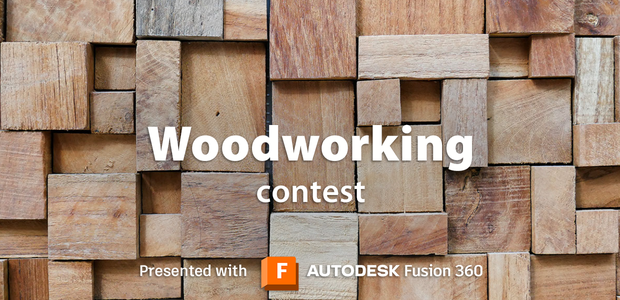Introduction: Double Live Edge Coffee Table
Here's a coffee table I made using a cross-section slab of 70 year old maple for the top, with legs made from a half-round log of dark walnut.
The naturally aged live edge of the maple slab flows smoothly into the outer live edge of the walnut legs, whose inner sides were sculpted to accentuate the natural shape of the walnut log.
It's a simple looking design that lets the rich natural detail of the end grain top really take the spotlight.
I'm proud to share how I made this. Scroll to the last step for more glamour shots.
Supplies
I got a few pieces of these old logs from a neighbor. He called it maple so I assume it is, but could be wrong.
It is rock-hard, bone-dry, and extremely heavy.
I used a chainsaw to take off a few 12 inch sections from these massive logs, and each seemed to weigh several hundred pounds.
These logs had been on the ground for at least a few decades when I got to them and there are 70 rings.
This project required common tools like a chainsaw, bandsaw, table saw, router, belt and orbital sanders, clamps and finishing supplies.
There are a few specialty items required as well: an Arbortech Turboplane used with an angle grinder, a small stiff wire brush or wire cup that can be used in a drill or die grinder, and a homemade lazy susan.
Step 1: Start Milling
These maple chunks are about 28 inches in diameter and the finished table is 16 inches tall.
I used a chainsaw to cut a slab about 4 inches thick from one of the larger chunks and then used the Turboplane to take it down to be as level and flat as could be done visually.
For the next step I put the slab on a simple homemade spinning lazy susan and built a gantry rail over the top using scrap wood and metal angle iron.
A router was used with a surfacing bit to remove about 1/16 inch at a time from the top face, until it was perfectly flat. The bit is set just lower than the highest point of the slab for the first pass, then lowered a little each additional pass until the entire slab is at the same level. Then the slab is flipped over and the process repeated.
Because of the lazy susan the router would self-feed in a way and spin the wood slab automatically. I had to keep firm pressure on the slab to slow it down so it wouldn't go out of control, and gradually slide the router to the center of the slab to complete each pass. It worked like a peach.
Step 2: Sand Sand Sand
This is incredibly hard wood in the first place but this is also the end grain so it's five times as hard to sand.
I started with 36 grit on a belt sander to remove all of the marks left by the router bit.
After this I sanded with 60 grit with an orbital sander until the faces appeared smooth and without marks. The wood was so hard that the 60 grit basically polished it so no additional sanding was needed. But these two steps took several days and made a lot of dust.
I mixed a little saw dust with glue and water to make a putty and filled in some small cracks in the wood. When they were dry they were sanded smooth.
Step 3: Start Legs
For the half-round piece of walnut log I started by prying off the bark. It came off easily for the most part.
Step 4: Cut Legs
The log half was cut into three wedges with a chainsaw. To do this safely I screwed the log to this board from the underside.
The three wedges were cut down using a bandsaw following the outer curvature of the log.
Step 5: Sculpt Legs
The three legs were sculpted using the Turboplane in an angle grinder. The leg pieces were clamped to a board to hold them while they were shaped. This requires some artistry and trial and error, constant checking and deciding how much to remove, from where, and when to just stop.
Step 6: Sand Legs
The legs were sanded with a 36 grit fiber disc in an angle grinder to smooth out the bumps left by the previous step. Then they were sanded with an orbital sander using 60 grit up to 120 grit sandpaper.
Step 7: Create Leg Steps
To join the legs to the maple slab I decided to use no fasteners at all.
Instead I built a simple jig to help make a Z step at the top of each leg. This results in 5 different faces being mated/glued to the slab later on, which is a sufficiently strong joint.
The jig was made out of scrap wood along with some toggle clamps. Scrap bits of wood and hard rubber were used as shims to bring the legs into the correct position, and the toggle clamps were locked down to hold the legs in place.
The jig was then used on a homemade cross cut sled on the table saw to cut the top end of the leg square.*
The blade is lowered and then the step area is nibbled away one pass at a time, moving the jig a little after each pass.
*This initial first cut isn't completely possible on the table saw (blade didn't raise high enough) so the jig with the leg fixed in place is taken to the band saw to carefully complete that first cut. Then it is returned to the table saw to make the step portion.
Step 8: Steps in the Slab
The individual legs were traced in the location on the round slab where they were to be joined and then I used a router to make the matching steps in the slab. The depth of the router bit is critical so extra care has to be taken in the setup.
Tape was placed around the step area so the glue squeeze-out wouldn't stain the surrounding wood. Glue was added to all the faces where the pieces would meet and clamps were used to hold the legs in place while the glue dried. This was done one leg at a time.
Step 9: Level the Table
The table legs are now in place but each one is a little different height. Shims were added to level out the table top and then each leg was marked at the same height to indicate where to remove material to make the whole thing level.
Step 10: Final Shaping
In order to create the look of the legs mating perfectly with the maple slab I had to do a little bit of subtle shaping and blending. This was done with the Turboplane followed by lightly sanding with an orbital sander.
Some walnut saw dust was used with a little glue and water to make a putty to fill little holes and gaps that were visible where the legs joined the table top.
To recreate the natural rough edges of the wood, a stiff wire cup brush was used to gently gouge the wood in any place where it had been sanded smooth.
The leg bottoms were sanded smooth and given a slight round edge. Some gentle sanding was done by hand along all the sharp edges of the entire table with 220 sand paper.
Step 11: Finish
The table was coated with several coats of Danish oil to seal the wood and give it a warm natural color. It was then allowed to cure for three days.
After the oil was cured I coated the table with a dozen or so coats of semi-gloss lacquer. Between the initial coats of lacquer the table was sanded very lightly with 220 grit sandpaper by hand, and between the later coats it was buffed with a very fine scotchbrite pad. After the final coat of lacquer it was not buffed or sanded.
Step 12: Final Look
People can't resist being drawn in to examine the fine details of the wood, count the rings, and discover the intricate details provided by nature.
This isn't a flashy piece, but there is a fascinating reward here for those that stop to take a closer look.
Thank you for reviewing my creative process. I hope you learned something useful.

This is an entry in the
Woodworking Contest











6 Comments
Question 1 day ago on Step 8
How much does it weigh?
Answer 12 hours ago
It weighs about 60 pounds.
1 day ago
My thumbnail is a live edge chunk of aromatic cedar that was felled by Hurricane Michael. Love your design... now to find legs!
Reply 1 day ago
Thank you for the compliment! That's cedar slab is beautiful, best of luck in your quest!
5 days ago
This table turned out great! You should consider entering it in the Woodworking Contest :)
Reply 5 days ago
Hey thanks!